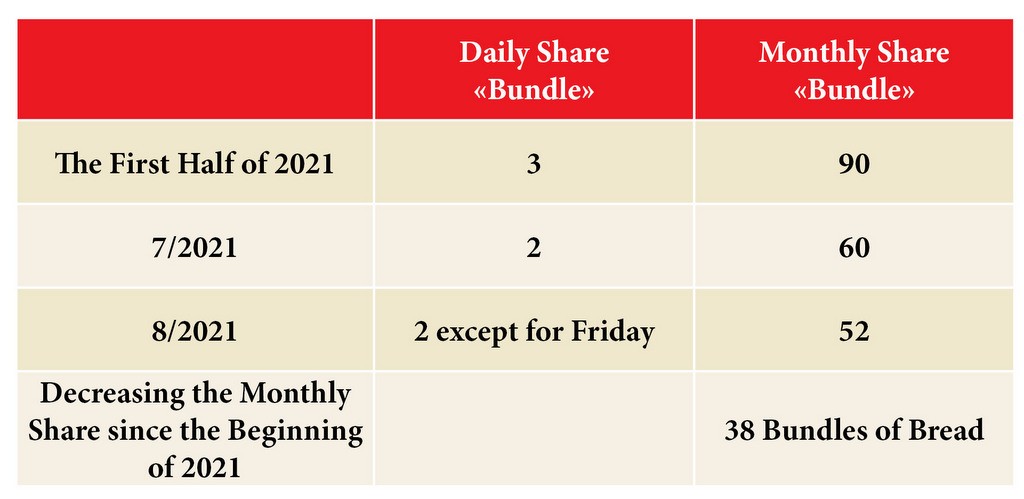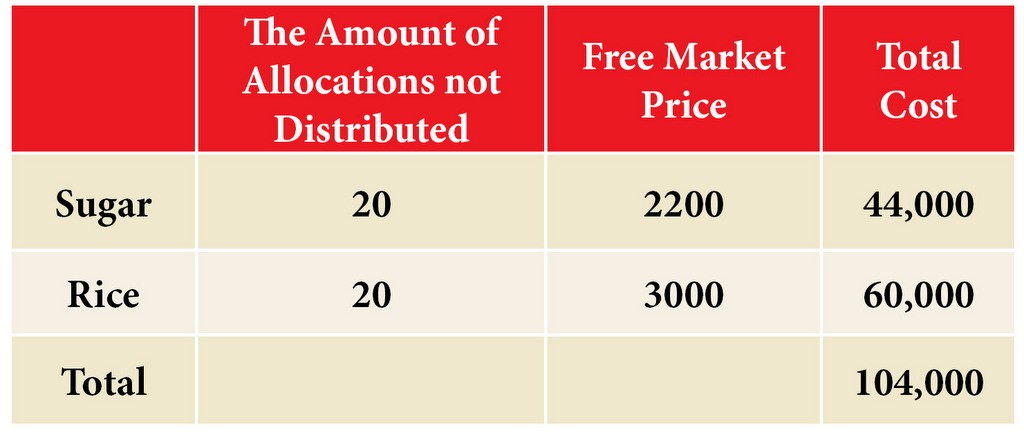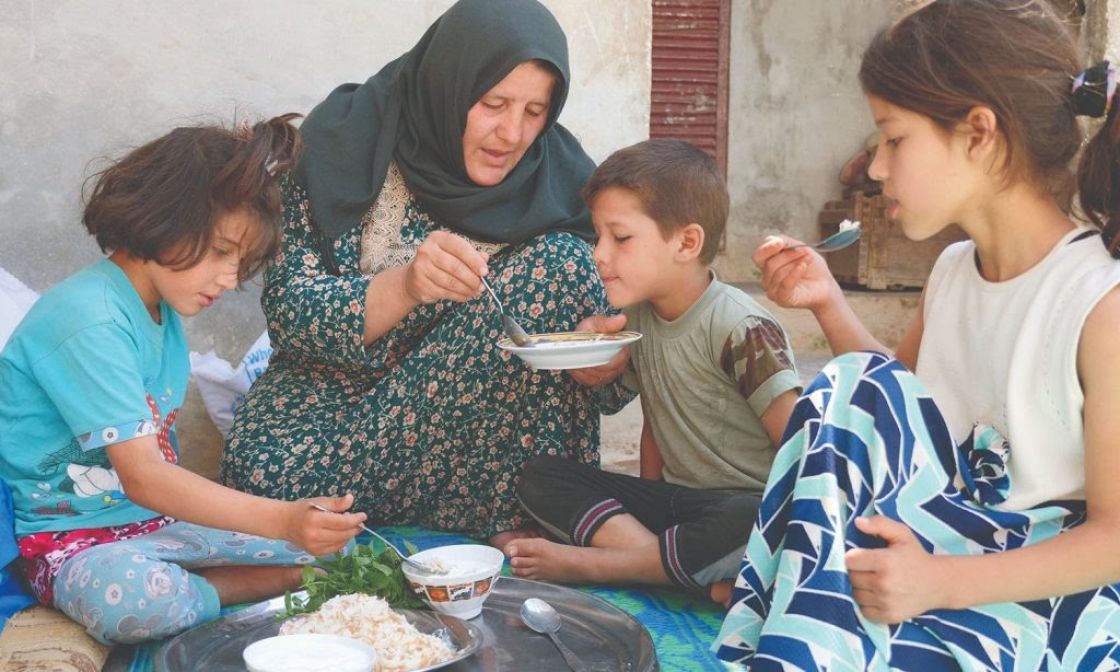- Articles
- Posted
Families’ Loss due to Reducing Subsidies in 2021
Another year of tragedy has passed, leaving many painful images in the depths of the Syrian memory. Another year that still caries an image of the spillover of the crisis, carrying the smell of war with it in a new way!
During the year 2021, like the other spillover years of the crisis, the most severe liberal resolutions have become even more brutal. Those resolutions have drawn more sorrow and harshness on the faces of citizens, and a lot of “electronic” waiting [in digital cues pending to get the governmental subsides] that Syrians were coercively accustomed to. From long hours they spend waiting for a few minutes of electricity where they run in a race against time to meet as much as they can of their most important needs, to the strikes of successive official resolutions, which have fallen like a barrage of stones one after the other on the heads of Syrians. These resolutions that have crossed the red lines towards further reduction of subsidy, which was enough to increase the disastrous deterioration of living and service situation towards further deepening of poverty in empty pockets, and hunger in empty stomachs.
In the following, and through a calculation we will conduct on an average family of 5, we will review the resolutions issued on 2021 regarding reducing subsidy, which has included the most important "subsidized" basic materials, such as bread, grocery (sugar and rice), diesel oil, and LPG. In addition to their huge reflection on the living situation of the citizen, and which are coercively added to his/her degrading living costs.
Bread is the First Plundered Line of Defence
The "Smart Card" [A card eligible to Syrians through which they can purchase government-rationed, subsidized goods at authorized retailers every month] has interfered in subsidized materials one after the other since the beginning of 2020. Not only that, but almost no single month has passed without an amendment occurring towards further reduction of subsidy on one of these materials. Bread was one of them, as after applying the "sections system" in September 2020, and increasing the price of one bundle of bread from 50 to 100 SP during October of the same year, the share of a family of 5 decreased, from 4 bundles of bread – as was the case before applying the "sections system" – to 3 bundles per day. The policy of reducing subsidy did not end there, but it continued with the year 2020. It started on July 10 when the price of one bundle of bread was increased from 100 to 200 SP in bakeries, and was sold at 250 SP through distribution agents. Then, on the 25th of the same month, the "sections system" has been changed from 4 to 8 sections, carrying with it another hidden reduction of subsidy, for the share of a family of five to be decreased to 2 bundles of bread per day. Thereafter, the resolution of August 11 was issued again, which required all bakeries in Damascus to be closed on Friday. The last thing was the new distribution schedule that was issued on October 17, to be applied on December 25, 2021.
During this quick round, we see the results of these resolutions which have led to reducing subsidy, the quantitative on the one hand, and price increase on the other. If we project the reflection of its negative effect on a family of 5 throughout the year 2021, we find – according to the following table – that:

Emphasizing that the daily share of bread is not enough for the family, forcing them to resort to exploitation networks in the black market, and buy one bundle of bread at 1000 SP minimum. In addition to the fact that the weight of the bundle has decreased before 2021 from 1300 grams to 1100 grams. If the family was to compensate for the shortfall in their share with 38 bundles of bread a month through the black market, they will have to pay about 38000 SP per month. Also, considering that the reduction has started on July, we will find that the cost since then until the end of the year was approximately 228 thousand SP, as a value only without the weight loss difference of 200 grams per bundle of bread. That is, 7600 grams with 7 additional bundles of bread that have been reduced from the total benefit, to be bought at 7000 SP minimum from the alternatives of the black market, bringing the total amount that the family has lost as a result of reducing subsidy on bread to about 235 thousand SP.
LPG; from Bad to Worse
The LPG cylinder this year was not excluded from the policy of reducing subsidy, and like other subsidized materials, it has been repeatedly reduced, whether by raising the direct price or increasing the receipt period of LPG cylinders to their beneficiaries, with a changing period of time. For example, during the first quarter of the year, the limit of the receipt period exceeded 60 days, and in the second quarter of the year the limit increased again to become 70 days, then it reached 90 days in the third quarter. As for the end of the year, it settled on a receipt period between 60 – 70 days, given the fact that the declared period of replacement is still 23 days, and according to it, the family can have 15 replacement processes during the year. If we considered the average period of replacement is 70 days, the number of replacements during the year for each family will be about no more than 5 cylinders.
In other words, each family has lost 10 cylinders of LPG during the year. Also, changes have occurred on the price of the cylinder during 2021. The first was on March 15, as the sales price of the cylinder increased to 3850 SP, and its price through distribution agents reached between 4000 and 4500 SP. Then its price increased again on November 2 to 9700 SP, and with adding transportation fees it became 10450 SP, not to mention the reduction in the amount of LPG in the cylinder that has officially reached 10 Kg. In addition to the stolen amount of LPG from each cylinder, which reached half a kilo of its weight, through black corruption networks, as its profits in the pockets of those involved in the corruption are equivalent to hundreds of billions annually. Also, it is certain that the shortfall was being remedied by the head of the family through the black market to meet his needs. According to that, the loss of the family during the year as a value for the number of LPG cylinders only, without taking into account weight differences is as follows:

That is, the family has incurred a loss of 10 LPG cylinders that they had to secure through the black market at approximately 760,000 SP.
Food Supplies; a Reduction by twisted Methods
The loss of the Syrian family did not end there, but it also reached food supplies, as the number of distribution cycles during 2021 was limited to 3 distribution cycles. The first was in the middle of February, the second was on July 4, as in the beginning of this cycle the official price of sugar and rice was increased to 1000 SP after the price of 1 Kg of sugar was 500 SP and the price of rice was 600 SP, and the last cycle started on December 4. This default has been justified by the Ministry of Internal Trade and Consumer Protection with pretexts and twisted methods, sometimes due to lack of supplies, other times because of the availability of sugar and lack of rice. In addition to rice being infected with decay, or because not all citizens have received their benefits from both materials, which obliged them to extend distribution cycles for several months, and many other pretexts that fall under the policy of reducing subsidy that the government is determined to end. Especially that Syrian Trading has offered sugar, tea, and oil through its halls under the name “positive intervention”, and at its free market price. For example, rice is sold in the halls of Syrian Trading at 2200 SP, i.e., 4 Kg per month for each family through the Smart Card.
Wasn’t it more appropriating for the Ministry of Internal Trade to compensate for the shortfall that led Syrian families to lose their allocations for four months of the year? That means, 4 million families did not receive their full benefits of sugar and rice, as the loss of a family of 5 for four months is 20 Kg of sugar and 20 Kg of rice. Even though the amount of allocations from both materials does not meet the need, which forced citizens to buy sugar and rice at their free market price from markets and at an increased cost after reducing the number of distribution cycles. As for increasing the price of sugar by 100%, and the price of rice by 66%, we find that the loss of a family of 5 within the last two cycles is 20 Kg of sugar, as the cost on the previous price was about 10000 SP, whereas the cost on the new price is about 20000 SP. That is, an additional loss of 10000 SP on family costs, as the cost of 20 Kg of rice on the previous price was 12000 SP, whereas on the new price it is 20000 SP, i.e., a loss of 8000 SP.
As for the loss of a family of 5 of their allocations during the four months that was not compensated due to reducing the number of cycles, which was compensated through the free market, we find the following:

Diesel Oil; What’s Next After the 50 Liters?
Diesel oil has undergone several amendments during 2021, as is the case with any subsidized material and in favor of reducing subsidy as usual, whether through reducing the distributed amounts that are conditioned by the availability of supplies, or through raising the direct price. The benefits of the family were subject to several reductions that led to losing diesel oil by all means. At the beginning of the year, the allocations of one card were 200 Liters, and before that they were 400 Liters, then they got reduced in the middle of the year to become 100 Liters, and finally the last reduction reached 50 Liters! By taking into account that these allocations are not being distributed to all beneficiaries; not when they were 400 Liters, nor when they became 200 Liters, and not even in their current state which is 50 Liters. The legitimate question here is, is this amount, from which 150 Liters have been chopped since the beginning of the year, really entitled to be called “subsidized”? as this amount will not last for one week of winter. With all this suffocation in amounts, the price of subsidized diesel oil has been raised from 180 SP to 500 SP, to make things even worse. Through the following table, we illustrate the amount of loss as a value of the 150 Liters that have been reduced at the free market price:

Noting that the actual need that the family consumes in winter is no less than 500 Liters, i.e., at a cost of more than 1.5 million SP. So, can any low-income family afford these huge heating costs? The total losses are in millions. In the end, we find that the burden of additional costs resulting from the reduction of subsidy, and the chopping that took place during 2021 only, which forced citizens to compensate for it through the networks of the black market, was as follows:

There is no doubt that the total annual amount mentioned above as a loss is really huge to the pre-impoverished families. This is also by adding the differences in official prices due to reducing subsidy on the delivered allocated amounts from these materials, by weight and price, which in total amount to approximately 2 million SP from each Smart Card holder of the beneficiaries. So, if the average wage was about 100,000 SP, then 2 million SP exceed the annual average wage, i.e., the impoverished family will barely be able to secure their needs from just the five basic materials mentioned above!
Maintaining Distortion
With all these followed policies of reducing subsidy, until it was completely removed, some influential person brags that no country provides support as the government is doing today! Perhaps it should be mentioned that the policy of subsidy in itself is an expression of the distortion in the distribution of wealth between wages and profits, and in favor of profits, and that wages are not enough to cover the minimum cost of living. So, is the comparison with other countries that do not have that big difference between wages and the costs of living valid? By moving forward with the policies of reducing subsidy towards ending it, and in the absence of an alternative policy that corrects the deep distortion in the distribution of wealth, it seems that what is happening is further deepening it, towards more distortion and preservation, and of course more hunger, poverty, marginalization and humiliation of the dignity of citizens.



 Abeer Hadad
Abeer Hadad